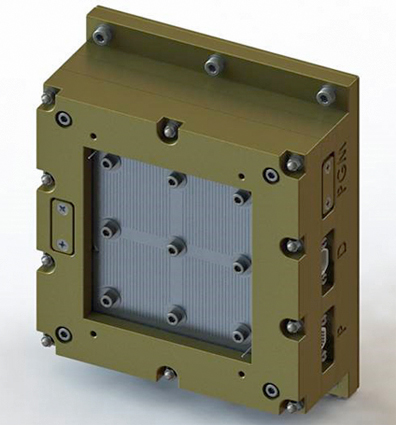[SatNews] Just as all rely on weather forecasts to be ready for rain or snow, satellite operators are increasingly looking to atmospheric scientists to predict the weather in space.
Fluctuations in temperature, plasma density, and ionic winds within various layers of Earth’s atmosphere can negatively impact the operation of certain satellites in orbit. Advanced warning of changes in space weather may enable satellite operators to anticipate communication disruptions and safeguard sensitive subsystems onboard.

iMESA-R instrument.Photo is courtesy of the U.S. Air Force Academy.
Surrey’s first OTB (Orbital Test Bed) mission will carry the Integrated Miniaturized Electrostatic Analyzer – Reflight (iMESA-R) instrument into orbit with the goal of improving the fidelity of space weather models compiled by scientists. Specifically, iMESA-R will measure charged particle energy from which plasma density and temperature in orbit can be derived.
“Computer models need three inputs to forecast space weather—temperature, density, and winds,” said Dr. Richard Balthazor of the Space Physics and Atmospheric Research Center (SPARC) at the U.S. Air Force Academy. “iMESA-R will measure the first two of those parameters in low-Earth orbit.”
He added that regardless of orbital altitude, space weather is an issue for every satellite as radio signals to and from the spacecraft must still pass through the turbulent atmosphere.
Aside from its value to future satellite operations, iMESA-R is noteworthy because it is being developed by Air Force Academy cadets at SPARC here in Colorado. SPARC is part of the Physics Department at the Academy where cadets are working alongside instructors such as Balthazor to design the iMESA-R sensor, write its operating software, and oversee final integration.
“We developed the design in-house at SPARC and then subcontracted to have electronics boards built and metal milling completed,” said Balthazor. “With support from the staff, cadets are doing the assembly and will perform much of the testing.”
Balthazor added that iMESA-R has drawn cadet participation from all sectors of the Academy. Electrical engineering majors played a big role in designing the hardware, while computer engineering students worked on the software. SPARC even has management students overseeing the programmatic side of the project.
“The first iMESA was developed in 2004, and two versions of it have flown on the International Space Station,” said Balthazor. “An iMESA-R very similar to the one under development now is currently flying on the STPSat-3 satellite.”
Scheduled for delivery to Surrey Satellite Technology US' Colorado assembly facility later in 2015, iMESA-R will boast several improvements over the STPSat-3 version. Most importantly, the SPARC team has found a way to shrink the instrument down to the size of an iPhone. Once in orbit aboard OTB, iMESA-R will continually measure ionic conditions for once-daily transmission back to the Surrey mission operations center in Colorado. SPARC will analyze the data quality and then forward it to atmospheric scientists for use in computer models that forecast space weather.
“Our goal is to fly the sensor on as many satellites as possible. A constellation of 25 could provide global coverage,” said Balthazor. “But we’ve demonstrated that even a modest number in orbit can improve space weather forecasts.”
SPARC won approval to fly on OTB from the U.S. Department of Defense Space Test Program, which monitors progress on satellite sensor projects in all four branches of the armed forces and ranks them by launch priority. Prior to delivery for integration at our assembly facility, cadets will oversee a variety of calibration and testing activities in the Academy’s thermal vacuum chamber. With participation from SPARC faculty and cadets, final testing of iMESA-R will occur in our facility after we have integrated the instrument into the OTB spacecraft in preparation for launch in 2016.
This article is courtesy of the Surrey Satellite US Blog.